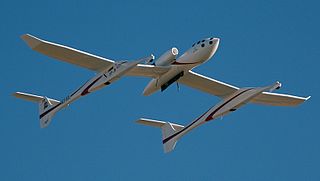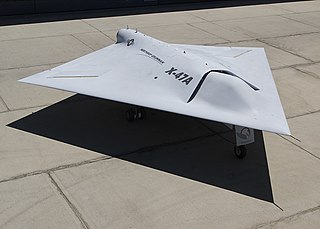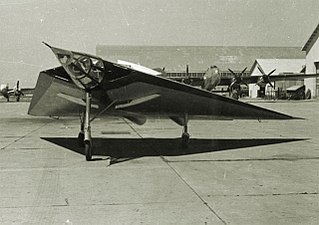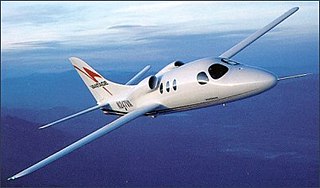
The Raytheon T-1 Jayhawk is a twin-engined jet aircraft used by the United States Air Force for advanced pilot training. T-1A students go on to fly airlift and tanker aircraft. The T-400 is a similar version for the Japan Air Self-Defense Force.

The Scaled Composites Model 318 White Knight is a jet-powered carrier aircraft that was used to launch its companion SpaceShipOne, an experimental spaceplane. The White Knight and SpaceShipOne were designed by Burt Rutan and manufactured by Scaled Composites, a private company founded by Rutan in 1982. On three separate flights in 2004, White Knight conducted SpaceShipOne into flight, and SpaceShipOne then performed a sub-orbital spaceflight, becoming the first private craft to reach space.

The Northrop Grumman X-47 is a demonstration unmanned combat aerial vehicle. The X-47 began as part of DARPA's J-UCAS program, and is now part of the United States Navy's UCAS-D program to create a carrier-based unmanned aircraft. Unlike the Boeing X-45, initial Pegasus development was company-funded. The original vehicle carries the designation X-47A Pegasus, while the follow-on naval version is designated X-47B.

The Republic XF-103 was an American project to develop a powerful missile-armed interceptor aircraft capable of destroying Soviet bombers while flying at speeds as high as Mach 3. Despite a prolonged development, it never progressed past the mockup stage.
The EF 132 was a planned jet bomber, under development for the Luftwaffe during World War II. It was the last aircraft project development undertaken by Junkers during the war, and was the culmination of the Ju 287 design started in 1942.

The Scaled Composites ARES is a demonstrator aircraft built by Scaled Composites. ARES is an acronym for Agile Responsive Effective Support.

The Cessna Citation II models are light corporate jets built by Cessna as part of the Citation family. Stretched from the Citation I, the Model 550 was announced in September 1976, first flew on January 31, 1977, and was certified in March 1978. The II/SP is a single pilot version, the improved S/II first flew on February 14, 1984 and the Citation Bravo, a stretched S/II with new avionics and more powerful P&WC PW530A turbofans, first flew on April 25, 1995. The United States Navy adopted a version of the S/II as the T-47A. Production ceased in 2006 after 1,184 of all variants were delivered.

The Pratt & Whitney Canada JT15D is a small turbofan engine built by Pratt & Whitney Canada. It was introduced in 1971 at 2,200 lbf (9,800 N) thrust, and has since undergone a series of upgrades to just over 3,000 lbf (13 kN) thrust in the latest versions. It is the primary powerplant for a wide variety of smaller jet aircraft, notably business jets.

The Williams V-Jet II was designed and built by Burt Rutan's Scaled Composites for Williams International as a test bed and demonstrator aircraft for Williams' new FJX-1 turbofan engine.

The Scaled Composites Triumph is a twin-engine, business jet prototype designed and built by Burt Rutan's Scaled Composites for Beechcraft. It was known officially as the Model 143, and internally at Scaled as the "Tuna". The aircraft is a three lifting surface design, with both a small canard, and a small conventional horizontal stabilizer in a T-tail configuration.

The EFW N-20 Aiguillon was Switzerland's first indigenous jet fighter project. The Swiss Federal Aircraft Factory developed a design for a four-engined swept winged fighter following the end of the Second World War. An unpowered sub-scale N-20.01 glider and a turbojet powered test aircraft, also sub-scale and known as the N-20.02 Arbalète ("Crossbow"), were test flown. A fighter prototype N-20.10 Aiguillon was built but never flown, and a twin-engines N.20.20 Harpon was also proposed but not followed up.

The Cessna Citation V is a business jet built by Cessna that was in production from 1989 until 2011. During that time, 774 such craft were made. The first Model 560 prototype, a stretched version of the Citation S/II, flew in August 1987 and was certified on December 9, 1988.

The FMA I.Ae. 37 was a prototype jet fighter developed in Argentina during the 1950s. It never flew and was cancelled in 1960.

The VisionAire VA-10 Vantage is a prototype single-engined light business-jet designed and developed by the American company VisionAire Jets Corporation. Originally planned for production in the late 1990s, the original VisionAire Corporation failed in 2003. The project was acquired by Eviation Jets, which planned to produce it as the redesigned EV-20 Vantage Jet. Eviation also failed, and in 2012 the design was relaunched by a revived VisionAire under its original design.

The Scaled Composites Model 351 Stratolaunch or Roc is an aircraft built by Scaled Composites for Stratolaunch Systems to carry air-launch-to-orbit (ALTO) rockets, and subsequently repurposed to offer air launch hypersonic flight testing after a change of ownership. It was announced in December 2011, rolled out in May 2017, and flew for the first time on April 13, 2019, shortly after the death of founder Paul Allen. The aircraft features a twin-fuselage design and the longest wingspan ever flown, at 385 feet (117 m), surpassing the Hughes H-4 Hercules "Spruce Goose" flying boat of 321 feet (98 m). The Stratolaunch is intended to carry a 550,000-pound (250 t) payload and has a 1,300,000-pound (590 t) maximum takeoff weight.

The Focke-Wulf 1000x1000x1000, also known as Focke-Wulf Fw 239, was a twinjet bomber project for the Luftwaffe, designed by the Focke-Wulf aircraft manufacturing company during the last years of the Third Reich.

The ScaleWings SW51 Mustang, formerly marketed as the FK-Lightplanes FK51 Mustang, is an Austrian ultralight, light-sport aircraft and homebuilt aircraft that was designed by ScaleWings of Strasswalchen, Austria and was initially produced by FK-Lightplanes of Krosno, Poland, who introduced it publicly at the AERO Friedrichshafen show in 2013. After FK-Lightplanes ceased production, the design was built by ScaleWings.
The Stargate YT-33 is an American homebuilt aircraft that was designed and intended to be produced by Stargate, Inc of McMinnville, Oregon, introduced in 1994. The aircraft is a 2/3 scale replica of the Lockheed T-33 jet trainer.
The Stratos 714 is an American very light jet aircraft under development by Stratos Aircraft of Redmond, Oregon. The project was announced in July 2008, a prototype first flew on 21 November 2016, although Stratos currently lacks the funding to complete type certification. Predominantly made of carbon composite, the single turbofan aircraft would seat four to six at 400 kn (740 km/h) over up to 1,500 nmi (2,800 km).
The McDonnell HRH, company designation Model 78, was a 1950s transport helicopter proposal for the United States Marine Corps (USMC) by McDonnell Aircraft, designed to operate from Commencement Bay-class escort carriers.

















